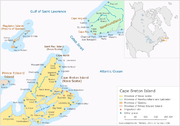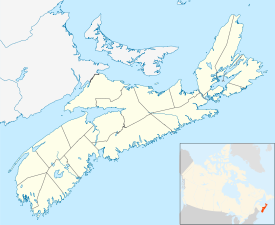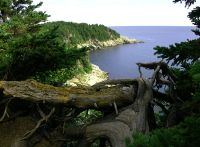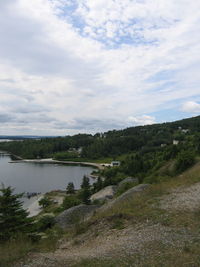Cape Breton Island
| Native name: Únamakika (Mi'kmaq) | |
|---|---|
 Cape Breton Island, Nova Scotia, Canada |
|
 Cape Breton Island (Nova Scotia)
|
|
| Geography | |
| Location | Atlantic Ocean |
| Area | 10,311 km2 (3,981.1 sq mi) |
| Area rank | 77th |
| Highest elevation | 532 m (1,745 ft) |
| Highest point | White Hill |
| Country | |
|
Canada
|
|
| Province | |
| Largest city | Sydney |
| Demographics | |
| Population | 147,454 (as of 2001) |
| Density | 14.30 /km2 (37.04 /sq mi) |

Cape Breton Island (French: île du Cap-Breton—formerly île Royale, Scottish Gaelic: Eilean Cheap Breatainn, Míkmaq: Únamakika, simply: Cape Breton) is an island on the Atlantic coast of North America. It likely corresponds to the word Breton, which is French for Brittany.
Cape Breton Island is part of the province of Nova Scotia, Canada. Although physically separated from the Nova Scotia peninsula by the Strait of Canso, it is artificially connected to mainland Nova Scotia by the Canso Causeway. The island is located east-northeast of the mainland with its northern and western coasts fronting on the Gulf of Saint Lawrence; its western coast also forming the eastern limits of the Northumberland Strait. The eastern and southern coasts front the Atlantic Ocean; its eastern coast also forming the western limits of the Cabot Strait. Its landmass slopes upward from south to north, culminating in the highlands of its northern cape. One of the world's largest salt water lakes (Bras d'Or--"Arm of Gold" in French), dominates the centre of the island.
The island is divided into four of Nova Scotia's eighteen counties: Cape Breton, Inverness, Richmond, and Victoria. Their total population as of the 2001 census numbered 147,454 "Cape Bretoners"; this is approximately 16% of the provincial population. Cape Breton Island has experienced a decline in population of approximately 6.8% since the previous census in 1996. Approximately 72% of the island's population is located in the Cape Breton Regional Municipality (CBRM) which includes all of Cape Breton County and is often referred to as Industrial Cape Breton, given the history of coal mining and steel manufacturing in this area.
The island contains five reserves of the Mi'kmaq Nation, these being: Eskasoni, Membertou, Wagmatcook, We'kopaq/Waycobah, and Potlotek/Chapel Island. Eskasoni is the largest in both population and land area.
Contents |
History







Cape Breton Island's first residents were likely Maritime Archaic natives, ancestors of the Mi'kmaq, the latter of whom inhabited the island at the time of European discovery. Giovanni Caboto (John Cabot) reportedly visited the island in 1497 to become the first Renaissance European explorer to visit present-day Canada. However, historians are unclear as to whether Cabot first visited Newfoundland or Cape Breton Island. This discovery is commemorated by Cape Breton's Cabot Trail, and by Cabot's Landing Historic Site & Provincial Park, located near the village of Dingwall.
A fishing colony was established on the island about 1521–22 by the Portuguese under João Álvares Fagundes. As many as 200 settlers lived in the nameless village in what is now present day Ingonish (location according to some historians) on the island's northwestern peninsula. The fate of the colony is unknown, but it is mentioned as late as 1570.[1]
On February 8, 1631, Charles I granted Cape Breton Island to Robert Gordon of Lochinvar and his son Robert.
Known as "Île Royale" to the French, the island also saw active settlement by France as part of the colony of Acadia. After the French ceded its colonies on Newfoundland and the Acadian mainland to the British by the Treaty of Utrecht in 1713, the French relocated the population of Plaisance, Newfoundland to Île Royale and the French garrison was established in the central eastern part at Ste. Anne. As the harbour at Ste. Anne experienced icing problems, it was decided to construct a much larger fortification at Louisbourg to improve defences at the entrance to the Gulf of Saint Lawrence and defend France's fishing fleet on the Grand Banks.[2] The French also built the Louisbourg Lighthouse in 1734, the first lighthouse in Canada and one of the first in North America. In addition to Cape Breton Island, the French colony of Île Royale also included Île St.-Jean (today called Prince Edward Island). Louisbourg itself was one of the most important commercial and military centres in New France. Although Louisbourg was captured by New Englanders with British naval assistance in 1745[3] and by the British again in 1758, Île Royale remained formally part of colonial France until it was ceded to Britain under the Treaty of Paris in 1763. Britain merged the island with its adjacent colony of Nova Scotia (present day peninsular Nova Scotia and New Brunswick).
Some of the first British-sanctioned settlers to the island following the Seven Years' War were Irish, although upon settlement, they merged with local French communities to form a culture rich in both music and tradition. From 1763 to 1784 the island was administratively part of the colony of Nova Scotia and governed from Halifax.
The first permanently settled Scottish community on Cape Breton Island was Judique, settled in 1775 by Michael Mor MacDonald. He spent his first winter using his upside-down boat for shelter, which is reflected in the architecture of the village's Community Centre. He composed a song about the area called "O's alainn an t-aite", or "Fair is the Place."
In 1784, Britain split the colony of Nova Scotia into three separate colonies: New Brunswick, Cape Breton Island, and present-day peninsular Nova Scotia, in addition to the adjacent colonies of St. John's Island (renamed Prince Edward Island in 1798) and Newfoundland. The colony of Cape Breton Island had its capital at Sydney on its namesake harbour fronting on Spanish Bay and the Cabot Strait. Its first Lieutenant-Governor was Joseph Frederick Wallet DesBarres (1784–1787) and his successor was William Macarmick (1787). From 1799 to 1807 the military commandant was John Despard, brother of Edward.[4]
An order forbidding the granting of land in Cape Breton, issued in 1763, was removed in 1784. The mineral rights to the island were given over to the Crown by an order-in-council. The British government had intended that the Crown take over the operation of the mines when Cape Breton was made a colony, but this was never done, probably because of the rehabilitation cost of the mines. The mines were in a neglected state, caused by careless operations dating back at least to the time of the final fall of Louisbourg.
Large scale shipbuilding began in the 1790s, beginning with schooners for local trade moving in the 1820s to larger brigs and brigantines, mostly built for British shipowners. Shipbuilding peaked in the 1850s, marked in 1851 by the full rigged ship Lord Clarendon, the largest wooden ship ever built in Cape Breton.
In 1820, the colony of Cape Breton Island was merged for the second time with Nova Scotia. This development is one of the factors which led to large-scale industrial development in the Sydney Coal Field of eastern Cape Breton County (see Industrial Cape Breton). By the late 19th century, as a result of the faster shipping, expanding fishery and industrialization of the island, exchanges of people between the island of Newfoundland and Cape Breton increased beginning a cultural exchange that continues to this day.
During the first half of the 19th century, Cape Breton Island experienced an influx of Highland Scots numbering approximately 50,000 as a result of the Highland Clearances. Today, the descendants of the Highland Scots dominate Cape Breton Island's culture, particularly in rural communities. To this day Gaelic is still the first language of a number of elderly Cape Bretoners. A campaign of violence and intimidation by the provincial school board led to the near extermination of Gaelic culture. The growing influence of English-dominated media from outside the Scottish communities saw the use of this language erode quickly during the 20th century. Many of the Scots who immigrated there were either Roman Catholics or Presbyterians, which can be seen in a number of island landmarks and place names.
The 1920s were some of the most violent times in Cape Breton. They were marked by several severe labour disputes. The famous murder of William Davis by strike breakers, and the seizing of the New Waterford power plant by striking miners led to a major union sentiment that persists to this day in some circles. William Davis Miners' Memorial Day is celebrated in coal mining towns to commemorate the deaths of miners at the hands of the coal companies.
Promotions for tourism beginning in the 1950s recognized the importance of the Scottish culture to the province, and the provincial government started encouraging the use of Gaelic once again. The establishment of funding for the Gaelic College of Celtic Arts and Crafts and formal Gaelic language courses in public schools are intended to address the near-loss of this culture to English assimilation.
The turn of the 20th century saw Cape Breton Island at the forefront of scientific achievement with the now-famous activities launched by inventors Alexander Graham Bell and Guglielmo Marconi.
Following his successful invention of the telephone and being relatively wealthy, Bell acquired land near Baddeck in 1885, largely due to surroundings reminiscent of his early years in Scotland. He established a summer estate complete with research laboratories, working with deaf people—including Helen Keller—and continued to invent. Baddeck would be the site of his experiments with hydrofoil technologies as well as the Aerial Experiment Association, financed by his wife, which saw the first powered flight in the British Empire when the AEA Silver Dart took off from the ice-covered waters of Bras d'Or Lake. Bell also built the forerunner to the iron lung and he experimented with breeding sheep.
Marconi's contributions to Cape Breton Island were somewhat less than Bell's as he merely used the island's geography to his advantage in transmitting the first North American trans-Atlantic radio message from a station constructed at Table Head in Glace Bay to a receiving station at Poldhu in Cornwall, England.
Geography

The island measures 10,311 square kilometres (3,981 sq mi) in area, making it the 77th largest island in the world and Canada's 18th largest island. Cape Breton Island is composed mainly of rocky shores, rolling farmland, glacial valleys, barren headlands, mountains, woods and plateaus. Geological evidence suggests that at least part of the island was originally joined with present-day Scotland and Norway, now separated by millions of years of continental drift.
The northern portion of Cape Breton Island is dominated by the Cape Breton Highlands, commonly shortened to simply the "Highlands", which are an extension of the Appalachian mountain chain. The Highlands comprise the northern portions of Inverness and Victoria counties. In 1936 the federal government established the Cape Breton Highlands National Park covering 949 km2 (366 sq mi) across the northern third of the Highlands. The Cabot Trail scenic highway also encircles the coastal perimeter of the plateau.
Cape Breton Island's hydrological features include the Bras d'Or Lake system, a salt-water fjord at the heart of the island, and freshwater features including Lake Ainslie, the Margaree River system, and the Mira River. Innumerable smaller rivers and streams drain into the Bras d'Or Lake estuary and onto the Gulf of St. Lawrence and Atlantic coasts.
Cape Breton Island is joined to the mainland by the Canso Causeway, which was completed in 1955, enabling direct road and rail traffic to and from the island, but requiring marine traffic to pass through the Canso Canal at the eastern end of the causeway.
Cape Breton Island is divided into four counties: Cape Breton, Inverness, Richmond, and Victoria.
Demographics
The island's residents can be grouped into five main cultures; Scottish, Mi'kmaq, Acadian, Irish, and English, with respective languages Gaelic, Mi'kmaq, French, and English. English is now the primary spoken language, though Mi'kmaq, Gaelic and French are still heard.
Later migrations of Black Loyalists, Italians, and Eastern Europeans mostly settled in the eastern part of the island around the Industrial Cape Breton region. The population of Cape Breton Island has been in decline for almost two decades with an increasing population exodus in recent years due to economic conditions.
According to the Census of Canada, the population of Cape Breton Island in 2001 was 147,454, a 6.8% decline from 158,260 in 1996.
Ethnic composition
Religious groups
Statistics Canada in 2001 reported a "religion" total of 107,880 for Cape Breton, including 3,915 with "no religious affiliation."[5] Major categories included:
- Roman Catholic: 69,820
- Protestant: 32,575 (including 13,790 United Church and 10,170 Anglican)
- Orthodox: 395
- Jewish: 235
- Muslim: 135
Synagogues in Sydney and Glace Bay serve a small historic Jewish community (which was once one of the larger ones in eastern Canada) while more recent Muslim immigrants hold Friday prayers at Cape Breton University. Buddhists are a tiny minority (70 in 2001, according to Statistics Canada), although Gampo Abbey in Pleasant Bay has been operational since 1984.
Economy



Cape Breton Island has two major coal deposits: the Sydney Coal Field in the southeastern part of the island along the Atlantic Ocean drove the Industrial Cape Breton economy throughout the 19th and 20th centuries—until after World War II its industries were the largest private employers in Canada; the Inverness Coal Field in the western part of the island along the Gulf of St. Lawrence is significantly smaller but hosted several mines.
Sydney has traditionally been the main port, with various facilities in a large, sheltered, natural harbour. It is the island's largest commercial centre and home to the ``Cape Breton Post`` daily newspaper, as well as its only active television studio, CJCB-TV, and several radio stations. The Marine Atlantic terminal at North Sydney is the terminal for large ferries travelling to Channel–Port aux Basques and seasonally to Argentia on the island of Newfoundland.
Point Edward on the west side of Sydney Harbour is the location of Sydport, a former navy base (HMCS Protector) now converted to commercial use. The Canadian Coast Guard College is located nearby at Westmount. Petroleum, bulk coal, and cruise ship facilities are also located in Sydney Harbour.
Glace Bay is the second largest urban community in population and was the island's main coal mining centre until its last mine ceased operation in the 1980s. Glace Bay served as the hub of the Sydney & Louisburg Railway and also as a major fishing port. At one time, Glace Bay was known as the largest town in Nova Scotia, based on population.
Port Hawkesbury has risen to prominence since the completion of the Canso Causeway and Canso Canal created an artificial deep-water port, allowing extensive petrochemical, pulp and paper, and gypsum handling facilities to be established. The Strait of Canso is completely navigable to Seawaymax vessels, and Port Hawkesbury is open to the deepest-draught vessels on the world's oceans. Large marine vessels may also enter Bras d'Or Lake through the Great Bras d'Or channel whereas small craft have the additional use of the Little Bras d'Or channel or St. Peters Canal. The St. Peters Canal is no longer used by commercial shipping on Cape Breton Island but is an important waterway for recreational vessels.
The industrial Cape Breton area faced several challenges with the closure of the Cape Breton Development Corporation's (DEVCO) coal mines and the Sydney Steel Corporation's (SYSCO) steel mill. In recent years the Island's residents have been attempting to diversify the area economy by investing in tourism developments, call centres, and small businesses, as well as manufacturing ventures in such fields as auto parts, pharmaceuticals, and window glazings.
While the Cape Breton Regional Municipality is in transition from an industrial to a service-based economy, the rest of Cape Breton Island outside of the industrial area surrounding Sydney-Glace Bay has been more stable, with a mixture of fishing, forestry, small-scale agriculture, and tourism.
Tourism in particular has grown throughout the post-Second World War era, especially the growth in vehicle-based touring, which was furthered by the creation of the Cabot Trail scenic drive. The scenery of the island is rivalled in northeastern North America only by Newfoundland and Cape Breton Island tourism marketing places a heavy emphasis on its Scottish Gaelic heritage through events such as the Celtic Colours Festival, held each October, as well as promotions through the Gaelic College of Celtic Arts and Crafts.
Whale-watching is a popular attraction for tourists. Whale-watching cruises are operated by numerous vendors from Baddeck to Cheticamp. The most popular species of whale found in Cape Breton's waters is the Pilot whale.
The primary east-west road on the island is Highway 105, the Trans-Canada Highway, although Trunk 4 is also heavily used. Highway 125 is an important arterial route around Sydney Harbour in the Cape Breton Regional Municipality. The Cabot Trail, circling the Cape Breton Highlands, and Trunk 19, along the western coast of the island, are important secondary roads. Railway connections between the port of Sydney to Canadian National Railway in Truro are maintained by the Cape Breton and Central Nova Scotia Railway.
The Cabot Trail is a scenic road circuit around and over the Cape Breton Highlands with spectacular coastal vistas; over 400,000 visitors drive the Cabot Trail each summer and fall. Coupled with the Fortress of Louisbourg, it has driven the growth of the tourism industry on the island in recent decades. The Condé Nast travel guide has rated Cape Breton Island as one of the best island destinations in the world.
Traditional music
Cape Breton is well known for its traditional fiddle music, which was brought to North America by Scottish immigrants during the Highland Clearances. The traditional style has been well preserved in Cape Breton, and céilidhs have become a popular attraction for summer tourists. Inverness County in particular has a heavy concentration of musical activity, with regular performances in communities such as Mabou and Judique. Judique is recognized as 'Bhaile nam Fonn', (literally: Village of Tunes) or the 'Home of Celtic Music', featuring the Celtic Music Interpretive Centre. Performers who have received significant recognition outside of Cape Breton include Buddy MacMaster, Natalie MacMaster, Ashley MacIsaac, The Rankin Family, Aselin Debison, and the Barra MacNeils.
The Men of the Deeps are a male choral group of current and former miners from the industrial Cape Breton area.
Film and television
- Squanto: A Warrior's Tale starring Adam Beach
- Johnny Belinda (1948 film) by Elmer Blaney Harris.
- Margaret's Museum starring Helena Bonham Carter.
- The Bay Boy starring Kiefer Sutherland.
- New Waterford Girl
- The Hanging Garden
- Marion Bridge
- My Bloody Valentine
- Pit Pony, TV movie and series adapted from the novel by Joyce Barkhouse
Notable people
The Arts
- Kate Beaton, webcomic artist, winner of the 2009 Doug Wright Award for "Best Emerging Talent"
- Nathan Bishop, singer-songwriter from Celtae
- John Allan Cameron, singer-songwriter, from Glencoe Station, credited as the "Godfather" of Cape Breton's modern Celtic music revival
- Nathan Cohen, theatre critic, CBC Radio host and personality
- Joe Cormier, fiddle player, Cheticamp.[6][7]
- J. P. Cormier, singer-songwriter, fiddle, mandolin, banjo guitar-player, Cheticamp.
- Lesley Crewe, Author of Relative Happiness and Shoot Me
- Mark Day, film & television actor, writer, and producer from Port Hawkesbury
- Aselin Debison, singer-songwriter
- Don Domanski, poet
- Andrew Doyle, singer-songwriter from Sydney Mines
- Winston "Scotty" Fitzgerald, fiddle player from White Point, Victoria County, Nova Scotia
- Robert Frank, photographer
- Danny Gallivan, Hockey Night in Canada sportscaster
- Bruce Guthro, singer-songwriter
- Angus MacAskill, giant and circus performer
- Ashley MacIsaac, fiddle player from Creignish
- Daniel MacIvor, actor, playwright, theatre director and film director from Sydney
- Hugh MacLennan, Governor General's Awards winning Author Barometer Rising, and Two Solitudes.
- Alistair MacLeod, author
- The Barra MacNeils, singing group
- Rita MacNeil, singer-songwriter, from Big Pond
- Buddy MacMaster, fiddle player from Judique
- Natalie MacMaster, fiddle player from Troy
- Erin Martell, singer, songwriter, painter.
- Matt Minglewood, musician
- Farley Mowat, writer, has his summer residence in Cape Breton[8]
- Scott Oake, Hockey Night in Canada sportscaster
- Daniel Petrie, Hollywood filmmaker
- The Rankin Family, singers-songwriters, from Mabou
- Rick Ravanello, actor, Hart's War, various TV series including 24, CSI and Desperate Housewives
- Harold Russell, Academy Award winning actor for his portrayal of Homer Parrish, in the 1946 film The Best Years of Our Lives.
- Gordie Sampson, singer/songwriter
- Richard Serra, sculptor
- Slowcoaster, rock band
- Tom Fun Orchestra
- Duncan Wells, singer-songwriter
Athletes
- Paul Boutilier
- Aaron Johnson
- Al MacInnis
- Mike McPhee
- Johnny Miles
- Bobby Smith
- Doug Sulliman
Politics and business
- John Buchanan, Premier of Nova Scotia
- Mayann Francis, First Black Lieutenant Governor of Nova Scotia
- Gordon Sidney Harrington, Premier of Nova Scotia
- Angus L. MacDonald, Premier of Nova Scotia
- Finlay MacDonald, Senator
- Rodney MacDonald, Premier of Nova Scotia
- Allan MacEachen, Former Deputy Prime Minister / Finance Minister
- Russell MacLellan, Premier of Nova Scotia
- Elizabeth May, Leader of the Green Party of Canada
- John W. Morgan, Mayor of Cape Breton Regional Municipality
- George Henry Murray, Premier of Nova Scotia
- Lisa Raitt, Federal Minister of Natural Resources
- Irving Schwartz, Businessman, Philanthropist, member of the Order of Canada
Religion
- Moses Coady, Roman Catholic priest, helped found the Co-operative Antigonish Movement at St. Francis Xavier University
- Moses E. Kiley, Roman Catholic archbishop of the Roman Catholic Archdiocese of Milwaukee, Milwaukee, Wisconsin
- James "Father Jimmy" Tompkins, Roman Catholic priest, helped found the Co-operative Antigonish Movement at St. Francis Xavier University
- Reverend A.W.R. MacKenzie, Presbyterian Minister, founder, Gaelic College of Celtic Arts and Crafts, St Ann's Harbour, 1938
- Reverend Norman McLeod, Presbyterian minister, St Ann's, who migrated in the 1850s with 800 settlers from surrounding communities to Waipu, New Zealand.
See also
- Canadian Gaelic
- Cape Breton accent
- Cape Breton Labour Party
- Cape Breton Regional Municipality, Nova Scotia
- Provinces and territories of Canada
- Province of Cape Breton Island
References
- ↑ de Souza, Francisco; Tratado das Ilhas Novas, 1570
- ↑ Canadian Military Heritage; vol.1, Chapter 6: Soldiers of the Atlantic Seaboard, p103. Government of Canada, 2004-04-26
- ↑ ibid., p112.
- ↑ Despard, John; The Companion to British History, Routledge
- ↑ Table from Statistics Canada (Nova Scotia Statistics Agency)
- ↑ Joe Cormier, North American Traditions
- ↑ Joe Cormier, The Midsummer Revels, January 23, 2001
- ↑ "Finding Farley - crossing Canada by canoe". Calgary Herald. 9 May 2007. http://www.canada.com/calgaryherald/story.html?id=b33f200f-a26b-40d8-8864-2ca7567fb12c&k=47973. Retrieved 24 August 2010.
- Counties of Nova Scotia; Statistics Canada
- Sea islands: Natural Resources Canada Atlas of Canada
- Cape Breton County and its divisions, Nova Scotia; Statistics Canada
External links
- Cape Breton Wireless Heritage Society
- Province of Cape Breton Island
- Flags of Cape Breton Island, on Flags of the World.net website
|
|||||||||||||||||||||||||||||